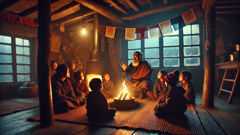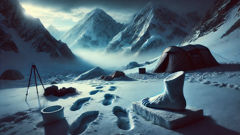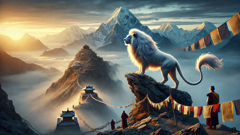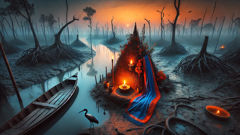Introduction
High on the wind-whipped shoulders of Nepal, where the air thins and the sky feels like a vast, cold ocean, legends live as steadily as the stone. The Yeti—called metoh, meh-Teh, or jangali manush by different tongues, and sometimes whispered as the Abominable Snowman—hovers at the edge of what people will give a name. For centuries the creature has been more than a rumor on tea-house benches; it is a presence threaded through Sherpa prayers, Mongol caravan tales, and the modern notebooks of climbers. Its story is not only footprints in snow or a smear of hair in a glacier camp; it's the collection of voices that rise in the thin air: the yak-breeders who report strange calls at dusk, the lama who speaks of an old protector of passes, the scientist who arrives with measuring devices and restraint, and the child who draws a hairy shape in the dust and believes without question. In the villages that crouch below the peaks, the Yeti binds landscape and memory. The mountains themselves feel responsible for the creature—an unfinished sentence of rock and ice that resists the tidy explanations of maps and weather reports. This narrative moves between those lives: the customs that have kept the Yeti at once feared and respected, the expeditions that sought proof and left with footprints and more questions, and the way modern pressures—climate change, tourism, and a global appetite for mysteries—have re-carved the contours of the tale. Here, among prayer flags, kharkas, and the slow exhale of glaciers, the Yeti persists as a figure of nature's intelligence and humanity's hunger to know what remains wild. What follows is an immersion into that wildness, a careful assembling of memory and observation, a long listen to the mountain's stories that refuse to be reduced.
Origins, Oral Memory, and the Shape of Belief
The first whispers of a large, apelike presence in the high Himalayas belong to people who keep close company with those mountains. Sherpa and Rai elders often speak of a creature that is part of the land itself—neither wholly dangerous nor easily domesticated into fear. Their words frame the Yeti as a being that steps across ecological borders: a forest thing that climbs into the snow, a mountain thing that descends into the villages when food runs low. In oral accounts gathered across valleys and passes, the Yeti takes on a moral quality. It is said to take only what the mountains allow and to punish those who take without respect. Because these stories were transmitted at firesides and in the quiet spaces of prayer before difficult climbs, they carry a rhythm that modern reports cannot replicate. They are saturated with the textures of daily survival—yak bells, the clink of tea bowls, the scent of tsampa—and they teach practices as plainly as tales: leave offerings at certain shrines to keep the high places safe; do not cut down the cedar that marks a boundary; treat a footprint with reverence rather than with a desire to claim it. In the villages, the Yeti is woven into ritual life. Lamas recite mantras to ward off misfortune associated with crossing certain high passes. Porters will sometimes leave a small portion of stew or barley at a rock they say belongs to the Yeti’s path. These gestures are not superstition alone; they are part of a reciprocal ethic between humans and a landscape that has always required humility.

Anthropologically, the Yeti illustrates how communities make sense of the unknown by folding it into moral economies. Anthropologists who have worked in the region note that myths like the Yeti function as a kind of social glue, enforcing etiquette, respecting elders' knowledge, and marking spaces where the human is obliged to show restraint. There is a fine line between belief and practice: whether or not an individual truly believes in an extraordinary creature, the rituals surrounding it influence how people treat fragile mountain ecosystems. In that way the Yeti narrative becomes a kind of environmental governance: a way of creating rules and taboos that slow the extraction of resources and respect corridors of wildlife movement. Oral accounts frequently mention the appearance of the Yeti in seasons of ecological stress—when barley fails, when avalanches reshape passes—suggesting that the creature’s role as an omen or agent emerges from real environmental concern.
As contact with outsiders increased during the twentieth century, the Yeti story moved beyond isolated valleys and into broader conversation. Early colonial explorers and later Western climbers recorded sightings, often through interpreters, then sent photographs and specimens to museums. These first encounters were mediated by translation and predisposition: a Sherpa’s term for an unusual bear track might be heard through the filter of English curiosity as evidence of a mysterious biped. Yet even with these layers of interpretation, the core of local testimony remained strikingly consistent: the presence of large footprints, sometimes humanlike but disproportionate; an elongated stride that suggested greater height than a typical mountain ungulate; and reports of a stench at certain sites—an animal scent described as sour and unfamiliar. In the local idiom, these signs were not mere thrills but practical knowledge—warnings about where to avoid, where to leave offerings, and where the weather or the mountain's mood might shift suddenly. This practical aspect of the Yeti myth allowed it to survive the age of instant communication. It adapted to new audiences without shedding its original purpose, which was less about proving an animal on a specimen table than about describing and inhabiting a living, often dangerous, terrain.
In villages and monasteries, the Yeti’s image is rarely monstrous in isolation. It is contextualized within a cosmology in which spirits of rock, snow, and animal coexist alongside human ancestors. The story grows complicated in urban centers and in tourist narratives when it is separated from these cultural frameworks and turned into a spectacle. In that transition, the Yeti becomes something to be hunted as evidence rather than to be respectfully acknowledged. Local elders often resent this flattening. For them, the Yeti’s dignity is bound to an ethic—treat the mountains with care and they will protect you. The anthropological record indicates that belief systems incorporating the Yeti encourage caution, respect for seasonal limits, and an acceptance of the mountain's unpredictability—values that are perhaps more vital now than ever, as climate change accelerates and increasing numbers of trekkers press higher and longer into fragile zones.
The oral archive also preserves diversity of detail. In one valley, storytellers emphasize the creature's reddish coat; in another, witnesses insist it is dark and shaggy. Children’s drawings might show a solitary figure under a full moon, while a lama's account ties the Yeti to an ancient guardian spirit of a glacier. That variability is not a weakness. It is a sign that the Yeti myth is a living, adaptive narrative. Like a river that changes course while remaining itself, the Yeti moves through language and custom, marking boundaries of the known and unknown. When modern researchers arrive with cameras and DNA swabs, they face a layered archive: physical traces that might be measured, and a human history that resists being reduced to a single, definitive story. The two archives—material and oral—inform one another, and when read together they yield a fuller sense of why the Yeti endures: it is human need to explain, and mountain patience that refuses explanation on the terms of the curious.
Evidence, Expeditions, and the Modern Search
When Western explorers began to press into the high Himalayas in greater numbers during the twentieth century, the Yeti was quickly rebranded in some quarters as the 'Abominable Snowman'—a name that carried theatrical weight. Expeditions were organized not only to reach summits but to measure and recover evidence. Photographs of footprints, strands of hair, and odd sounds were compiled. Some reports were earnest and methodical, others sensational. Scientists arrived bearing microscopes and skepticism; journalists carried notebooks that wanted a neat, marketable narrative. Over time, several lines of inquiry emerged: the study of tracks and gait, hair analysis, footprint casts, and behavioral ecology. Each contributed pieces to a messy puzzle, sometimes contradicting one another, often raising new questions.

Footprint casts—plaster molds made carefully in snow by early mountaineers and local guides—became a hallmark of the search. In many cases these prints were large and humanlike, with impressions suggesting a long stride. But snow is a tricky medium: sun, wind, and melt can stretch contours, creating illusions of size. Because mountaineers work under pressure and with limited time, casts sometimes prioritized speed over perfect technique, leaving later analysts to debate proportions. These imprecise conditions did not necessarily lessen the seriousness of the sightings. Sherpas, porters, and villagers who walked those ridges for generations offered corroborating accounts with details that careful field notes confirmed—sounds like distant wails, flattened patches of alpine grass, and a pungent smell sometimes reported near alleged encounters. When scientists applied modern techniques—DNA analysis, microscopic hair fiber comparisons, and environmental scanning—they found a more complicated picture. Some hair samples matched known species, like Himalayan brown bears or local ungulates. Others were degraded so badly by time and the elements that results were inconclusive.
Perhaps the most persistent line of scientific curiosity came from DNA studies. Advances in genetic analysis in the late twentieth and early twenty-first centuries allowed labs to analyze tiny fragments of hair, bone, or fecal matter with unprecedented sensitivity. Researchers compiled databases of known species’ mitochondrial DNA to compare against unknown samples. In several cases, initial excitement—promising signals that did not match known entries—gave way to more mundane conclusions: contamination, degraded DNA too fragmentary to identify, or matches to regional bears. Yet even those conclusions raised interesting questions about how local fauna behave at high altitudes. Himalayan brown bears and even the smaller Asiatic black bears sometimes wander into subalpine zones during certain years of forage scarcity, producing tracks and hair that might be misread by an observer primed to see a Yeti.
Beyond hard data, there remains a category of evidence that resists laboratory reduction: human testimony. Several well-documented sightings in the twentieth century came from experienced Himalayan workers—people who knew the land and its animals. Their accounts often included behaviors inconsistent with known species: upright walking for short distances, leaving tools or food untouched, vocalizations that sounded like a long, humanlike howl. To reconcile these claims, scholars in fields from ecology to folklore emphasize the need for interdisciplinary study. Ethology can examine potential behaviors of unknown or rare animals; climatology helps map when and where animals might be forced into new ranges; cultural studies unpack how narratives of the Yeti change with contact and commerce.
Tourism added a new vector to the story. As trekking routes grew popular, international visitors brought cameras and curiosity; a footprint image posted online could become viral within days, shaping outsider perceptions. Local economies adapted. Tea houses advertised 'Yeti-experience' treks and souvenirs proliferated. This commercialization did something else: it made the Yeti a bargaining chip between conservation and development. When a village positioned the Yeti as a cultural asset, the myth could help protect fragile zones by discouraging deforestation or reckless altitude routes. Conversely, when the search for proof turned into toil for tourism, it could erode local values and put pressure on sensitive habitats. Conservationists now find themselves in conversations about how to use cultural narratives ethically to promote environmental protection without exploiting local belief systems.
Recent efforts at collaborative research attempt to bridge respect for local knowledge and the rigor of scientific inquiry. Projects that include Sherpa guides, local elders, and Nepali scientists alongside international researchers have yielded richer data and better community relationships. Working together, teams have mapped patterns of sightings, cataloged environmental changes—such as receding glaciers and shifting treelines—and developed practical management strategies: seasonal closures, community-led monitoring, and bioacoustic stations placed in key passes to record sounds over months. These stations sometimes pick up ambiguous calls in the night: low-frequency rumbles, distant knocks, or a long moan that does not match known species in the database. Whether those sounds will ever be pinned to a single animal or a chorus of ecological phenomena remains undecided. What is clear is that the Yeti story has prompted methods of study that are as much about preserving a way of life as they are about proving a species. In that way, the continued search is less an expedition to capture and catalog and more a reluctant, hopeful attempt to translate mountain memory into terms that can be shared across cultures and disciplinary boundaries. The Yeti, in other words, continues to be both a subject of curiosity and a catalyst for cooperation between people who want to protect the places where such a thing might still be allowed to exist.
Conclusion
The Yeti persists because it occupies a space that humans find both alluring and unsettling: the boundary where cultural memory, ecology, and the unknown meet. The legend serves multiple purposes—practical, moral, and imaginative—reminding communities to respect environmental limits, offering scientists an object of rigorous curiosity, and giving outsiders a figure to fear or admire. As global pressures reshape the Himalayas, the Yeti's meaning may change more quickly than its image: climate-driven shifts in habitat, increased tourism, and economic pressures will alter the conditions under which sightings occur and how local custodians interpret them. Yet the deeper lesson remains steady. The Yeti asks us to slow down, to pay attention to footprints that wind away from the beaten trail, to listen for calls that sound like something between a wind gust and a human voice, and to consider how belief and evidence can coexist without canceling one another. Whether the creature is eventually placed in a museum drawer, reclassified as a known species, or left forever in the category of myth, the Yeti will have already accomplished something vital: it keeps alive a conversation about responsibility to wild places and the importance of honoring the knowledge of those who dwell there. In the end, the mountain does not belong to a single narrative. It holds many stories, and the Yeti stands at their crossroads—sometimes frightening, sometimes protective, but always a reminder that some parts of the world resist being fully mapped and that respect, curiosity, and humility remain our best guides when we enter them.













